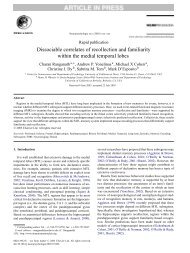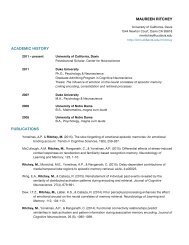CLINICAL EEG and NEUROSCIENCE - Dynamic Memory Lab
CLINICAL EEG and NEUROSCIENCE - Dynamic Memory Lab
CLINICAL EEG and NEUROSCIENCE - Dynamic Memory Lab
Create successful ePaper yourself
Turn your PDF publications into a flip-book with our unique Google optimized e-Paper software.
<strong>CLINICAL</strong> <strong>EEG</strong> <strong>and</strong> <strong>NEUROSCIENCE</strong> ©2007 VOL. 38 NO. 1ies of ERP activity recorded during encoding phases forsubsequent recognition testing. We then review the resultsof ERP investigations of retrieval.Encoding-related studiesRelative to non-semantic, or shallow encoding (forexample, processing orthographic features of words),semantic or deep encoding (as when making living/non-livingjudgments about words) leads to a greater likelihoodthat those words will be recognized on a subsequent memorytest. 5 By now, a large number of studies have shownthat the degree to which an item’s memory trace isenriched during encoding is determined by the amount oneelaborates upon the information retrieved from semanticmemory, 6 a phenomenon that can be labeled episodicencoding. Hence, semantic retrieval <strong>and</strong> episodic encodingappear to work in t<strong>and</strong>em, perhaps with semantic retrievaloccurring prior to episodic encoding.ERP investigators have assessed encoding-relatedprocessing by quantifying the differences in neural activityassociated with individual items during an encoding phasebased on whether or not those items are subsequentlyremembered. A subtraction of the ERPs elicited by studyitems that are subsequently forgotten from those that aresubsequently remembered yields the subsequent memoryeffect (SME), a measure of encoding. 7,8 SMEs usually, butnot always, have a positive polarity that is widely distributedacross the scalp. In their investigation, Paller <strong>and</strong> colleagues9 had subjects encode words under deep (e.g., is itliving?) <strong>and</strong> shallow (e.g., does the word contain 2 vowels?)conditions. In accord with Craik <strong>and</strong> Lockhart, 5semantic encoding engendered higher rates of recognitionsuccess compared to non-semantic encoding. Importantly,SMEs, which onset at roughly 400 ms <strong>and</strong> lasted about600 ms, were reliable under semantic but not non-semanticconditions. Hence, SMEs have been associated withsemantic encoding activity because their magnitude is positivelyrelated to the extent of deep encoding processesduring acquisition. 9 The question arises, however, as towhether SMEs are related to subsequent recollectioncomparedto familiarity-based retrievals.One method by which the distinction between recollection<strong>and</strong> familiarity has been demonstrated is with the“Remember/Know” paradigm. 10 In this paradigm, for itemsjudged old, subjects indicate whether their recognition decisionwas accompanied by the retrieval of contextual detail, a“remember” (R) judgment (i.e., a recollection-based retrieval),or was based on a feeling of familiarity with the item, a“know” (K) judgment (i.e., a familiarity-based retrieval).M o r e o v e r, items that are deeply encoded are associatedsubsequently with a greater proportion of R judgments,whereas items that are shallowly encoded are associatedsubsequently with a greater proportion of K responses.The R/K paradigm was used by Friedman <strong>and</strong> Trott 11 toassess whether recollection- <strong>and</strong> familiarity-basedretrievals had their origin during encoding. During the studyphase, participants were asked to memorize two nounsembedded in sentences for a subsequent recognition test.During the recognition test, subjects decided whethernouns were new or old <strong>and</strong>, for old nouns, made an additionalR/K judgment. The study phase ERPs were averagedinto three classes on the basis of subsequent recognitionperformance: 1) subsequently correctly recognized<strong>and</strong> given an R judgment, 2) subsequently correctly recognized<strong>and</strong> given a K judgment, <strong>and</strong> 3) subsequently unrecognized(i.e., a miss). SMEs were computed by subtractingthe ERPs associated with subsequently missed items fromthose associated with subsequent R <strong>and</strong> K judgments. Foryoung adults, reliable SMEs were observed in the intervalfrom 400 - 900 ms for study items associated with subsequentR judgments but not subsequent K judgments.These SME data suggest that recollection- <strong>and</strong> familiaritybasedrecognition judgments at retrieval had their origin inthe type of encoding activity engaged in during study.In addition to young adult participants, Friedman <strong>and</strong>Tr o t t 11 recruited older adults. There was some basis forexpecting age-related differences in ERP activity becausethe elderly had been shown to produce a smaller percentageof remember judgments than the young, 12 <strong>and</strong> to rely moreon familiarity than recollection when these two processesare placed in opposition. 13 , 14 Both findings suggest an agerelatedimbalance in the recollective component of recognitionmemory. Hence, Friedman <strong>and</strong> Tr o t t 11 d e t e r m i n e dwhether aging interacted with the familiarity/recollection distinctionin modulating encoding-related ERP a c t i v i t y. Comparedwith the data of the young described above, for thee l d e r l y, reliable SMEs were observed in association withboth subsequent R <strong>and</strong> K judgments. Friedman <strong>and</strong> Tr o t t 11concluded that, during the study phase, older subjects didnot differentially encode those items that would be subsequentlyassociated with retrieval of contextual details(remember) from those that would not (know). Furthermore,these data implicated age-related deficits in encoding ascontributing to episodic memory deficits in the elderly.These conclusions received some support from the distributionof SME activity across the scalp. For the young, inaddition to positive electrical activity, the SME for R judgmentswas associated with negative activity over left inferiorprefrontal scalp (LIPFS); there was no evidence of negativeactivity over LIPFS in the data of the elderly. 13 Thenegative activity could have reflected retrieval of informationfrom semantic memory, as R. Johnson <strong>and</strong> coworkers15 observed negative-going ERP activity over LIPFS inassociation with semantic but not orthographic decisions.Such results fit well with those of hemodynamic studiesshowing that the retrieval of semantic memories <strong>and</strong> theencoding of episodic memories depend upon activity inregions of the LIPF Cortex (LIPFC 16 ). Assuming that theblood flow <strong>and</strong> ERP data share at least some common3




